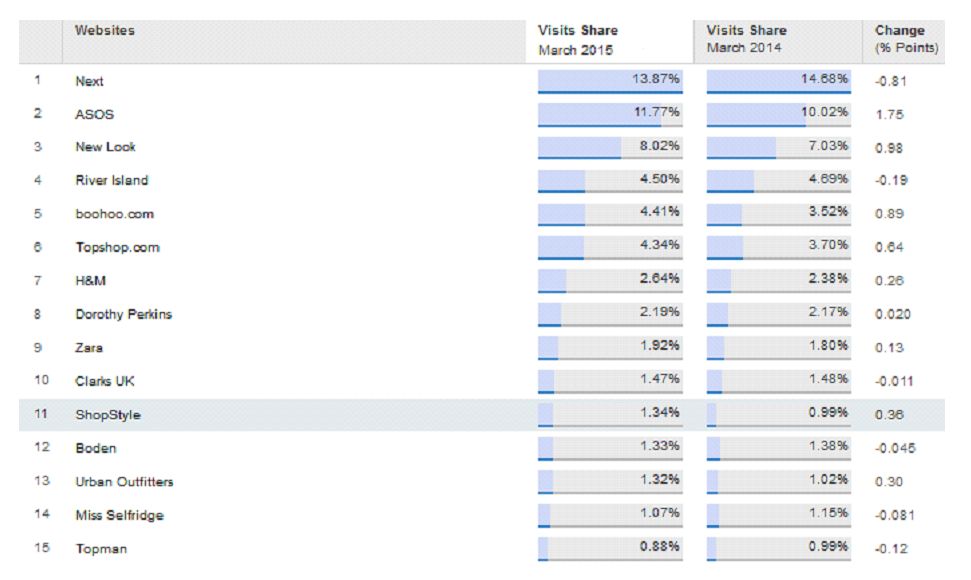The growth of affiliates as a brand has really come to light in the last 5 years. In the early days of affiliate marketing, the agenda was very much dictated by the advertiser; the advertiser would suggest promotion types, users they wanted to target, how they wanted to deliver volume and so on.
Now things are different and the relationship is very much a two way street. As affiliates have grown and built their own user bases, they are now in the position to drive the agenda forward. Each year we see technical advances across the publisher base as they gain greater insight into their growing member base and use this insight to make the best decisions for their users.
If we look at Hitwise data for the Fashion category, March 2015 vs March 2014, it is clear how rapidly affiliate brands are growing. In March 2014, Shopstyle sat in 19th place making up 0.99% of the overall traffic share for Fashion. Fast forward to March 2015, and they sit in 11th place, driving 1.34% of the share. Their growth has surpassed the likes of River Island, H&M and Dorothy Perkins.
This isn’t only seen in the fashion industry, uSwitch are also excelling in the energy industry with 4,744,079 visits and a 13% share of energy site traffic, sitting above many key advertisers in the Hitwise rankings. Whilst in the Insurance category, four of the top 10 brands are affiliates.
Affiliates, in a lot of cases, strive to be consumer champions – whether they aim to be the best money saving site, the best review site or simply the best aggregator of data.
So… how can you get your affiliate brand to be tussling at the top of the traffic tables with some of the UK’s most recognisable advertisers?
Set an outward facing goal and believe in it!
I know it sounds cheesy, but set a goal for the company that is outward facing, i.e. isn’t purely about profits.
Moneysupermarket.com does this very well:
“Our aim is to save 10,000,000 households more than £200 each in 2015.”
There is no hiding the fact the moneysupermarket.com is a profitable site, but having this outward facing goal is a clear indication that the company has objectives that aren’t just there to meet shareholder’s needs, but actually benefit the consumers that use the site. You don’t need to be the size of moneysupermarket.com to create a goal, but they’re a good way to ensure that you’re working towards helping your users in some way.
Try to give something back to your community
Maximising profits is a very short term concept; to ensure your brand has long term sustainability, you need to re-invest your earnings back into your users.
Remember to interact with your user base and ensure you foster a feel-good factor by giving them something back for their loyalty. As users start to love your brand, they go on to share their experience with their friends and become brand advocates in the process!
How about trying some of the following to thank your community?
- Competitions to win prizes.
- Passing some earnings back to the user like cashback or loyalty schemes.
- Birthday gift e.g. 20% code off a certain brand.
- Invitations to company events (perfect for bloggers and fashion orientated publishers).
- Providing 1-on-1 advice and expertise (perfect for considered purchases e.g. travel, utilities, insurance).
- Offering a percentage of company profit to charity.
Understand your users and how to connect with them
One of the biggest differentials I see when looking at large vs small publishers is how much data they have on their users. The biggest affiliate brands in the space have demographic make-ups and detailed user profiling, all of which isn’t just for show. This level of data allows the publisher to really understand who their users are, so they can target them with relevant and bespoke messaging, as well as ensuring the site is tailored to meet their needs.
Drilling into your data and pulling out your demographics isn’t an easy thing, and not every business can afford to invest in a Data Management Platform from the offset. But there are some great free tools out there which can help! My current favourite is the yougov profiler.
Just pop in brands that you push regularly, see what demographic they attract and tailor your communication strategy to match their user type. MAC and Royal Bank of Scotland are two examples of brands which have an entirely different make up (as you’d expect).



